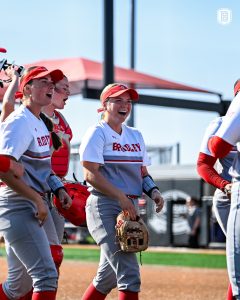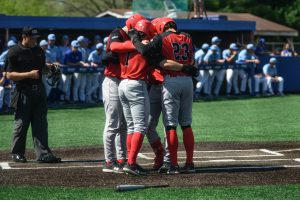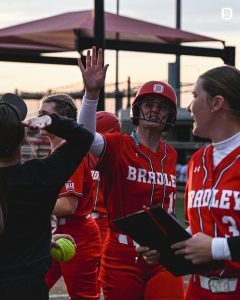This season, the men’s basketball team touts a number of new freshmen from all over the globe.
However, the cross country teams did that before it was cool, as they’ve been establishing an international recruiting pipeline from the United Kingdom to Peoria.
Currently, there are three international players on both rosters: freshmen Michael Ward and Haran Dunderdale and senior Rosie Hiles.
Although this pipeline began two cross country coaches ago in the Marc Burns era, its origins can be traced to assistant head coach Sam Bradley, who is also from the UK.
Bradley said getting in touch with potential international recruits is limited in terms of communication. However, a simpler way to get in touch with potential recruits has emerged: Facebook.
“That’s honestly the easiest way,” Bradley said. “We can do international calling from here, but it costs the school a bunch. We prefer Skype … It works just as well.”
In fact, Facebook was the main way in which Bradley recruited sophomore runner Haran Dunderdale, who hails from Grantham, England.
“In a recruiting sense, they just send you a Facebook message, because not everyone gets an email, so it’s an easy way,” Dunderdale said. “It’s cool how that’s how I ended up on the other side of the world.”
Dunderdale credits Bradley for being the architect who built the UK pipeline to the Hilltop, ascribing him with bringing more than just Dunderdale overseas.
“[Bradley] was the one who brought me, Rosie [Hiles] and [Michael Ward] over,” Dunderdale said. “He started it. There was one girl before us who only stayed for a year, she was a graduate student, and Rosie got in touch through her.”
Bradley was able to strike it big with Ward, who was a heavily recruited runner coming out of high school and winning his commitment meant battling heavy schools.
“Everyone wanted Mike Ward; we beat out some huge schools,” Ward said. “With Mike, we had to work a little bit harder. He was looking at about six schools, the likes of Florida State, Tulsa, notable cross country and track schools.”
This season, Hiles, Ward and Dunderdale played crucial roles in both the men’s and women’s cross country conference championships.
Although Ward is the top runner on the men’s team, Hiles and Dunderdale run as fourth and fifth runners, respectively, and finished in the top-25 in the MVC championship races.
The previous cross country coach Willy Wood did not have much of a background in international recruiting, but current head coach Darren Gauson dealt with it extensively during his time at Lamar University.
“Germany, Finland, Italy, England, so a good amount of countries,” Gauson said. “There wasn’t as much distance talent in Texas as what there is in the Midwest, so if we want to be competitive at the national level we recruit anywhere and everywhere.”
Gauson also noted how different the means are for recruiting internationally in smaller collegiate sports.
“If you’re in cross country, swimming, tennis, the world’s a lot smaller with Facebook, Twitter and email,” Gauson said. “There’s a lot of recruiting agencies out there now. I have a contact in Germany, they’ve got a website. There’s one in Britain called TrackboundUSA where you can sign up and they’ll send you athletes who are interested in coming over to the states.”
Bradley noted that using his prior experiences as a runner in England and coaching in America have also helped him with recruiting internationally.
“That’s the best thing, seeing both sides of the system,” Bradley said. “Seeing the British set-up and the system back there and then knowing the NCAA system and being able to see them both.”
Recruiting international athletes has its advantages in being able to boast talent from all over the world.
However, it doesn’t come without challenges.
“It’s harder to integrate international athletes into more of a team environment,” Gauson said. “If you are going to recruit internationally, it’s good to do, but with the right blend. You’ve got to get the right mixture between American and international.”
Along with creating a diverse amalgamation of athletes, Gauson said homesickness takes a toll on international athletes. That was a problem that never hampered the team.
“Coming so far away from home is always going to be tough,” Dunderdale said. “This team, it blew all of us away [with] how homely it was, last year especially. We literally had nothing with us. They help you academically, as well as physically.”
In the future, Gauson foresees the number of international athletes growing as more talent comes overseas to join NCAA programs.
The numbers back up that claim. According to the 1999-2010 NCAA student-athletes race/ethnicity report, the percent of international athletes has increased from 1.8 to 3.8 percent for males and 1.5 to 4.3 percent for females.
“Division I athletics is super competitive, and people want to win. So they’re going to look, not just here, they’re going to look at Canada, Mexico,” Gauson said. “If it’s a good student and a good person, and they’re very talented, then you’re going to go for them.”
However, to the athletes at Bradley, it doesn’t matter if they come from South Wales, London or Grantham. They’ve found a home in Peoria.
“It’s the family feel of the team, they all just stick together,” Dunderdale said. “They’re your best friends.”




